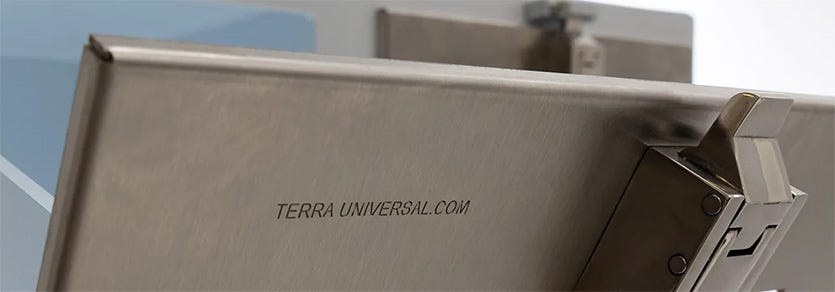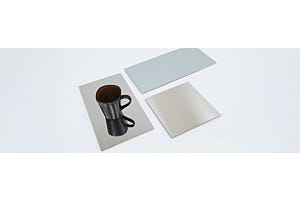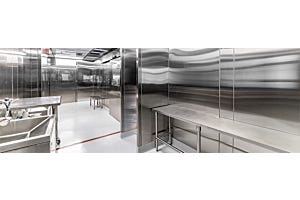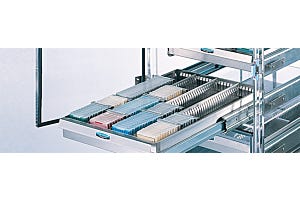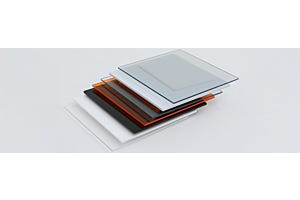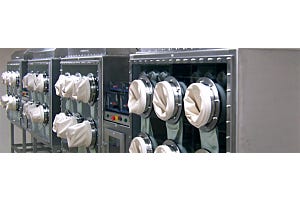Terra Universal manufactures a vast selection of stainless steel products for cleanrooms, hospitals, laboratories, and other controlled environments. Among these steel-constructed products, you'll find tables, workstations, glove boxes, pass-throughs, doors, and more.
There are several varieties of steel used to manufacture these products including 304, 304L, 316, and 316L stainless steel. So, let's unpack the differences between various stainless steel grades, finishes, and use cases.
304 vs 316 Stainless Steel Carbon, Molybdenum, Chromium Content
Chromium (Cr) is the primary alloying element in both 304 and 316 stainless steel that forms a passive oxide layer on the surface, providing fundamental corrosion resistance. While increasing chromium content generally enhances corrosion resistance, it does not significantly impact hardness or tensile strength within the 300-series grades. Nickel (Ni) and molybdenum (Mo) are also critical elements; nickel stabilizes the austenitic structure, and molybdenum improves resistance to pitting and crevice corrosion, particularly in chloride-rich environments.
Unlike 304 stainless steel, 316 stainless steel contains approximately 2-3% molybdenum, which significantly enhances resistance to corrosion in salt or chloride-laden environments and improves the material’s performance against localized corrosion, including pitting. To maintain the austenitic structure when adding molybdenum, nickel or nitrogen must also be present to balance the alloy. The increased nickel (10-14%) and molybdenum content in 316 stainless steel also contributes to its higher cost but is essential for applications demanding superior corrosion resistance, durability, and workability.
Nickel content in 304 stainless steel typically ranges from 8% to 10.5%, whereas in 316 stainless steel, it ranges from 10% to 14%. Higher nickel levels enhance the alloy's overall stability, resistance to oxidation, and protection against stress corrosion cracking, particularly in chloride-rich environments. Thus, 316 stainless steel's composition provides added protection and longevity in more aggressive conditions, justifying its use in marine, pharmaceutical, and chemical processing applications where exposure to chlorides and other corrosive substances is frequent.
316L vs 304L Stainless Steel Performance
304L stainless steel can be suitable for environments where certain chemicals, like sulfuric acid and phosphoric acid, are present at low concentrations. However, 316L stainless steel generally offers superior corrosion resistance in such environments, especially if chlorides are also present. The added molybdenum in 316L provides enhanced protection against corrosion from acids and other corrosive substances, making it more effective than 304L in these conditions.
316L stainless steel is particularly well-suited for marine and aquatic applications due to its improved resistance to pitting and crevice corrosion in saltwater, ice, and chloride-laden environments. It is also the preferred material for pharmaceutical and laboratory settings where exposure to aggressive chemicals and frequent cleaning with harsh agents like bleach-based disinfectants is common. In these settings, 316L's enhanced corrosion resistance, due to its higher nickel (10-14%) and molybdenum (2-3%) content, ensures durability and longevity.
In contrast, 304L stainless steel is less resistant to aggressive acids and chlorides, making it less ideal for demanding environments compared to 316L. However, 304L is highly ductile and formable, allowing for easy fabrication through processes like bending, forming, and drawing. It is well-suited for applications that require complex shapes or intricate designs. While it may not offer the same level of corrosion resistance as 316L, 304L still provides adequate mechanical strength and toughness for many applications, including structural components, piping, and containers.
Steel Composition by Type: 304 vs 304L vs 316 vs 316L
- 304: 18% chromium, 8% nickel, max 0.08% carbon
- 304L: 18% chromium (20% max), max 0.03% carbon
- 316: 16% chromium, 10% nickel, 2% molybdenum, max 0.08% carbon
- 316L: 16% chromium, 10% nickel, 2% molybdenum, max 0.03% carbon
304 vs 304L Stainless Steel Performance
304 stainless steel is one of the world's most commonly used metals, and it's found in virtually every commercial, retail, or manufacturing environment. Besides being strong, durable, and aesthetically engaging, 304 steel accommodates most uses that require durability, and reliable tensile strength, and offers a broad range of resistance against chemicals, moisture, and high temperatures.
304L stainless steel is an alloy made up of a low-carbon version of 304 stainless steel. Lower carbon content reduces the likeliness that the carbide precipitates during welding, which can lead to
304L stainless steel is a low-carbon version of 304 stainless steel, which makes it less susceptible to carbide precipitation during welding. Carbide precipitation occurs when chrome and carbon content within the metal is drawn out from the material, which can lead to rust and oxidation. 304L steel is an excellent choice for use in corrosion-resistant structures where post-weld heat treatment is not necessary.
When Should I Choose 316 Stainless Steel Instead of 304 Steel?

In scientific and cleanroom environments, chemical characteristics and cleanliness are critical performance factors. Importantly, one must also consider the composition of integrated features such as hardware, latches, handles, and assembly components.
There are several instances where 316 steel offers greater resistance to environmental factors. Generally, 316 steel is specified for environments where 304 stainless steel lacks adequate corrosion resistance:
- Marine and aquatic applications,
- Salt and ice are present in the environment
- Environments with strict cleanliness requirements
- Equipment is exposed to harsh chemical cleaners
When Should I Select 316L Steel vs 316?
Generally, 316 steel is specified for environments with strict cleanliness requirements, or when equipment is exposed to harsh chemical cleaners and corrosive environments that 304 stainless steel cannot withstand. In food and beverage industries, 316L offers increased protection against salt, proteins, and strong acids or bases. 316L possesses enhanced resistance to chlorides and chlorinated solutions that are common in controlled environments and cleanrooms, such as Spor-Klenz® and Isopropyl Acetate.
Why Does Chlorine Cause Stainless Steel to Corrode?
The corrosion susceptibility of austenitic stainless steels increases with chloride concentrations. Here's how it works:
- In the corrosion pit or crevice, the surrounding electrolyte gains positive electrical charges.
- A positively charged pit attracts negative ions of chlorine.
- Chloride ions from the ambient environment accumulate on the surface and cause the corrosion rate to increase.
- The chloride ions attack the passive films on the surface of stainless steel and react with the metal matrix to cause the growth of stress corrosion cracking.
Corrosion cracking is an important issue for stainless steel installations that will frequently be subjected to chlorinated chemicals, saltwater, or combinations of salt and ice typical with winter conditions.
Stainless Steel Alternatives for Cleanrooms
White powder-coated steel provides a clean and attractive aesthetic. The glossy finish gives a spotless and well-maintained appearance. It also helps spot dirty surfaces more easily.
Terra’s signature white powder coat finish provides a high-quality, durable barrier to protect against corrosion, plus a clean and attractive aesthetic. The advanced heat-fused formulation exceeds ASTM and ISO paint standards to resist chipping, scratching, fading, and wearing.
Electropolished Stainless Steel
Electropolished stainless steel equipment is typically used in applications where a high degree of cleanliness and precision is required, such as in the medical, pharmaceutical, and food and beverage industries. It is also commonly used in the production of surgical devices and other medical equipment.
Electropolishing improves the corrosion resistance and durability of the stainless steel, making it more resistant to wear and tear over time.
As a result, electropolishing also increases corrosion resistance and improves the ease of cleaning via a smooth, reflective surface with a mirror-like finish.
Need Help Selecting the Right Steel for Your Application?
Shop Terra Universal Products Online for immediate pricing or configure your components and accessories for quoting.
Contact a Terra Sales Specialist via phone, webchat, or email for help with configuration, large purchases, and application expertise.



